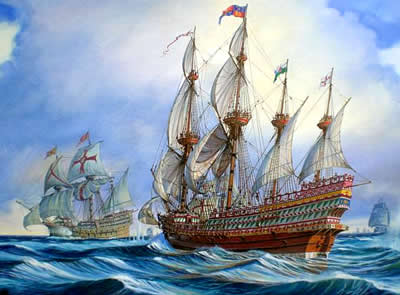 |
| Ships and Shipping |
By the 15th century, contact between seafarers from northern Europe and their counterparts in the Mediterranean had brought about the development of a number of ship types in use throughout Europe.
Ship-builders from the Atlantic seaboard borrowed frame-first construction techniques from the Mediterranean roundships and galleys, while southern European builders borrowed the more maneuverable square sail and the stern post rudder from ships built to weather the heavier seas of the Atlantic and North Sea.
The result of such cross-fertilization was a series of ship types that would not undergo any more radical transformations until the age of steam; a 15th century tall sailing ship had more in common with the vessels of the early 19th century than with those of only 100 years before.
  |
The basic ship types in use in Europe at the dawn of the 15th century were the carrack, a tall sailing vessel, and the galley. Much sleeker and lower in the water, the galley was propelled primarily by oars, though it also carried sails to be used in favorable conditions.
Sometimes very large, up to more than 1,000 tons, carracks were driven by three or four masts, each with one or two square sails, with the exception of the mizzenmast, the one nearest the rear or the stern of the ship, which carried a lateen sail.
Carracks were guided by a centrally mounted stern post rudder. These ships were often quite slow and cumbersome, their breadth being roughly two-thirds their length, but they were much more seaworthy than their medieval ancestors, the roundship and the cog.
The galley was smaller by comparison, ranging from 100 to 150 tons; was roughly eight times as long as it was wide; and carried either one or two masts fitted with lateen sails. They were steered by a pair of large oars fitted one on each side of the vessel.
All elements combined to make the galley a much faster ship: the lateen sail was much more efficient at harnessing the wind while the oars meant that the ship never got stuck in calms. The galley was also incomparably more expensive to operate. More sailors were necessary to work the great triangular sails, but most of all the hundreds of oarsmen had to be fed and even paid, unless they were slaves or convicts, as was often the case.
It was primarily the difference in operating costs that made the galley the vessel of choice for transporting light, expensive goods such as spices, silk, or precious metals through the Mediterranean, while bulky goods were sent over long distances in carracks.
Introduction of the Cannon
 |
| Cannon battle between ships |
The widespread introduction of cannon in the 16th century changed the face of shipmaking. Throughout the Middle Ages a ship’s fighting capacity and ability to defend itself resided in the number of able-bodied men it had aboard. This gave the galley an advantage; each oarsman could be given a sword. Artillery changed that.
Now a ship’s fighting ability was measured in the number of cannon the ship carried, and tall sailing ships could mount more guns than low, sleek galleys. Galleys did not disappear overnight, but by the 17th century, they were relegated more and more to patrolling coasts or providing rapid transport to dignitaries.
The carrack, on the other hand, continued to evolve. Hulls were lengthened in proportion to width, giving the vessels greater speed and stability. The results of this evolutionary process, the smaller caravel and the great galleons, became the instruments of European exploration and expansion.
   |
The European tradition, however, was far from universal. The Turkish fleets as well as those of North African ports were quick to adopt the changes introduced in European shipping, though the seafarers active in the Persian Gulf and Indian Ocean produced ships of a very different type.
Overseas and coastal trade tended to be carried in dhows, Arab vessels of varying sizes, which can still be found along the east coast of Africa and in the Red Sea. Dhows ranged from small craft to deep, oceangoing ships mounting one or two large lateen sails. The hulls, however, were made of planks fitted together and sewn to each other rather than nailed to an internal structure as in European ships.
Such ships were unable to stand up to the cannon-carrying European vessels that began arriving in the Indian Ocean in the early 16th century. As a result, Europeans were able to dictate the terms of shipping, but European shipbuilding techniques spread to the Indian Ocean area.
Chinese Ships
Chinese ships form a category of their own. The most important Chinese ship type, the junk, mounted a stern-post rudder as early as the 12th century, though it carried fanlike bamboo sails, lugsails, and had a squared, flat-bottomed hull.
By the 15th century, Chinese junks could be as large as 1,500 tons, and, unlike European vessels, were built in several watertight compartments. The centralized government of China failed, however, to encourage development of ocean-going sea power and, as a result, the Chinese presence on the sea diminished considerably beginning with the late 15th century.
European Trading Empires
The early modern period witnessed the expansion of European-based colonial and trading empires throughout much of the globe. That expansion would not have been possible without the developments in European shipbuilding techniques that came about during the 14th century. Substantially, the rest of the period merely witnessed the continued refinement of the ship types developed at the end of the Middle Ages.
These versatile vessels were then imitated both in the eastern Mediterranean and to a large degree among the long-distance traders of the Indian Ocean region as well. The Chinese, on the other hand, having developed a robust and seaworthy ship type of their own, remained largely impervious to the developments that had taken place in Europe and that had been adopted in so much of the world.